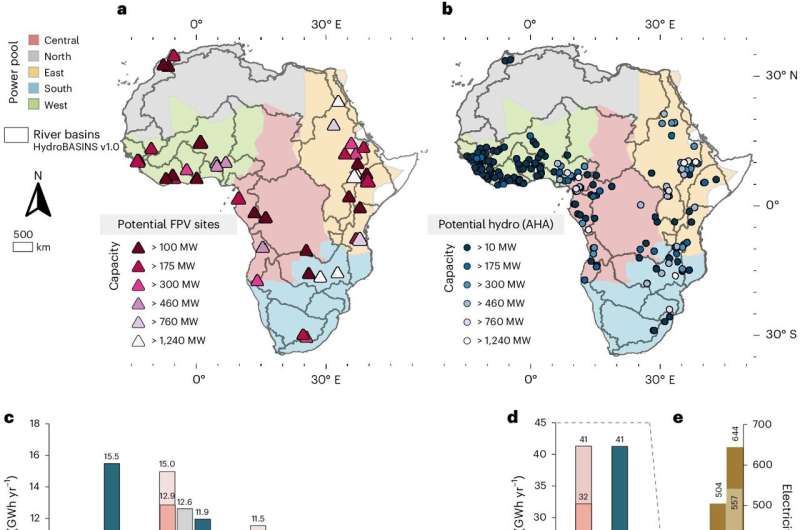
Floating photovoltaics (FPV), also known as floating solar farms, are photovoltaic systems that can be deployed on the sea’s surface or on other bodies of water. While their environmental impact is still the topic of debate worldwide, these systems could be highly advantageous for generating renewable energy, particularly in warm regions where available land is scarce or costly.
Researchers at Politecnico di Milano recently carried out a study exploring the potential of FPV systems for the future provision of energy in African countries. Their paper, published in Nature Energy, suggests that floating solar farms could prove valuable for limiting Africa’s reliance on hydropower, while also potentially offering a more reliable supply of energy.
“Our paper was inspired by the growing interest and potential of FPV as an emerging renewable energy technology, and the continued push for hydropower development in developing economies, particularly in Africa,” Wyatt Arnold, co-author of the paper, told Tech Xplore.
“Despite the environmental and social risks associated with large hydroelectric dams, many countries are still planning significant hydropower expansions to meet their rapidly growing energy demands. We wanted to explore whether FPV could serve as a viable alternative or complement to these planned hydropower projects.”
The recent study by Arnold and his colleagues Matteo Giuliani and Andrea Castelletti had two key objectives. The first was to estimate the potential of FPV as a future source of electricity in Africa, comparing it to planned investments in hydropower.
Secondly, the researchers set out to investigate the trade-offs and synergies between FPV and hydropower technology at a system level. Their analysis focused on a specific river basin, namely the Zambezi watercourse, considering the limitations posed by local electricity grid operations and competing water resource demands.
“We employed a multi-scale modeling approach,” Arnold explained. “Firstly, we considered FPV’s cost competitiveness within Africa’s future energy mix using a capacity expansion model (OSeMOSYS-TEMBA) covering the entire continent. This is an important step given the very large increase in projected electricity demand of many African countries over the 21st century and the transformation of its electricity system with a much larger share of variable renewable supply.”
To assess the trade-off between FPV and hydropower technology at a system scale, the researchers carried out further analyses focusing on the Zambezi watercourse. The Zambezi watercourse is a river basin that is shared by multiple African countries, where governments are planning to build various dams for hydro-power generation.
Arnold and his colleagues examined reservoir operations in the region and created models of the local electricity system. This allowed them to assess the potential of hydropower and FPV in this region, including their potential for expanding energy capacity and trade-offs with other uses of water resources, such as irrigation and environmental flows.
“One of the most notable contributions of our work is the quantitative, techno-economic assessment of FPV’s potential to contribute to Africa’s future electricity needs, in some cases matching or exceeding the expected output from planned hydropower dams,” Arnold said. “This finding challenges the continued emphasis on hydropower expansion in many African countries and suggests that FPV could be a viable alternative with fewer environmental and social impacts.”
The results of the system scale analysis carried out by Arnold, Giuliani and Castelletti suggest that investing in FPV on existing reservoirs along the Zambezi watercourse, while also building fewer dams, could be a better investment of capital than the intensive development of hydropower. Compared to dams, FPV were found to be more cost-efficient and robust to long-term environmental and hydrological changes.
“FPV can also help offset potential hydropower losses when reservoirs are re-operated to prioritize other water resource objectives, enabling a more balanced approach to water resource management,” Arnold said.
“The implications of our work are far-reaching, as it provides policymakers in developing economies with a comprehensive assessment of FPV’s potential and highlights its advantages over traditional hydropower development, particularly in terms of reduced environmental and social risks, increased resilience to hydrological variability, and more efficient use of capital investments.”
Overall, the analyses performed by this team of researchers suggest that floating solar farms could prevent African countries from becoming over-reliant on hydro-power in the future, thus limiting associated social, environmental, and financial risks. This key insight might inform future energy-related policymaking and investments in Africa, encouraging a shift towards FPV systems.
“In our next studies, we plan to explore the environmental implications of large-scale FPV adoption in river basins, including the effects on lake water quality and ecosystems,” Arnold added. “We also intend to further engage with stakeholders and policymakers through participatory processes to better understand the social and institutional barriers to FPV adoption and develop strategies to overcome them.”
